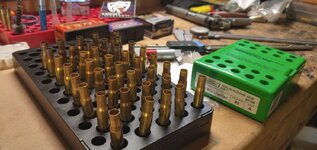Note: A standard die is 7/8-14 threads, so figuring out how much the die moves up and down by revolution is technically possible, thread tolerances notwithstanding.
The problem is 2 fold.....
1) Is elevating the die directly proportional to the amount of shoulder bump you need? E.g.: if you need to bump the case shoulder .003" can you just turn the die .003"? My guess is probably not.
2) Most full length dies will size the case well under the SAMMI minimum (to fit all chambers) so the real dilemma here is finding out what your die produces then backing off from there. Is the best way to do this to just FL size one case, measure the case datum (case headspace) then back the die off (in thousandths) by the difference from what you want the shoulder to be?
messy reloading bench pic for attention...

The problem is 2 fold.....
1) Is elevating the die directly proportional to the amount of shoulder bump you need? E.g.: if you need to bump the case shoulder .003" can you just turn the die .003"? My guess is probably not.
2) Most full length dies will size the case well under the SAMMI minimum (to fit all chambers) so the real dilemma here is finding out what your die produces then backing off from there. Is the best way to do this to just FL size one case, measure the case datum (case headspace) then back the die off (in thousandths) by the difference from what you want the shoulder to be?
messy reloading bench pic for attention...












